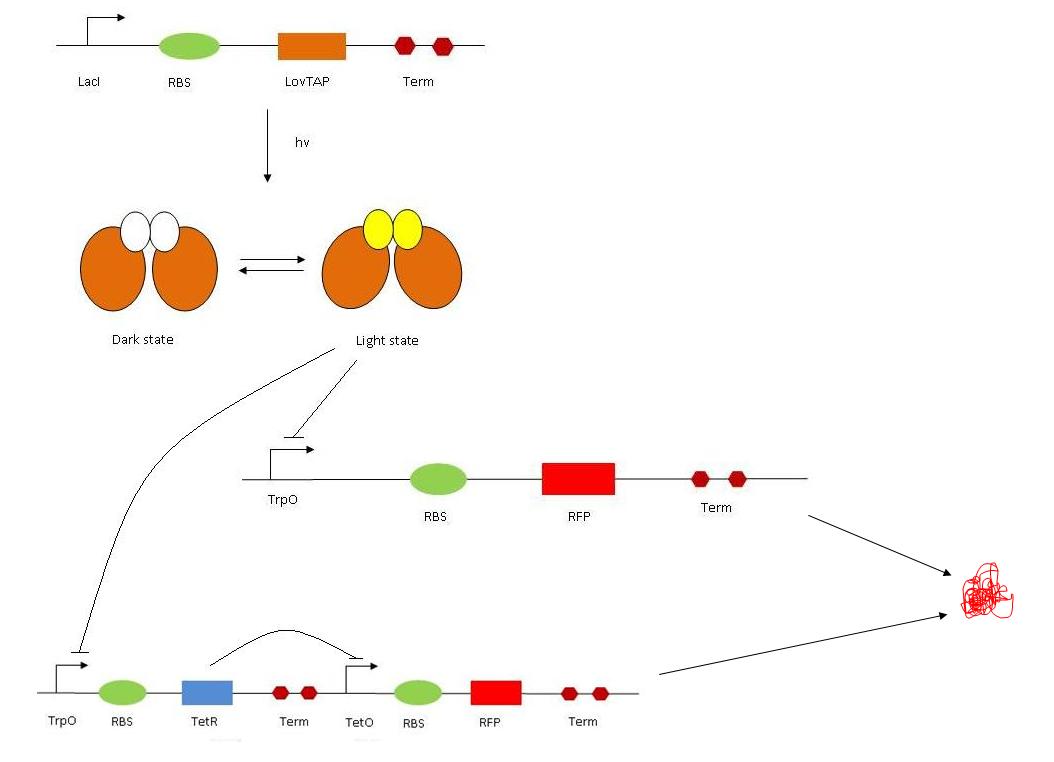Team:EPF-Lausanne/Strategy
From 2009.igem.org
Contents |
Strategy
Cloning strategy
Our aim was to create a biobrick containing LovTAP under the influence of an inducible promoter. This part needed to contain (in order) the inducible promoter (LacI), RBS (ribosome binding site), the LovTAP gene (that was generously sent by Pr. Sosnick form the University of Chicago) and finally a terminator (Term). This entire part was of course to be flanked by the standard prefix (E,X) and suffix (S,P). In order to synthesize this part, we proceeded in three steps :
1. We ligated the LovTAP gene into the terminator (we used a double terminator).
2. We also ligated LacI into RBS.
3. Finally we ligated these two parts together to obtain our biobrick (LacI-RBS in the LovTAP-term part).
So finally we got :
With this biobrick, we have an inducible system : when we add IPTG, the promoter activates the expression of the LovTAP protein.
Read out systems
Once we have our protein LovTAP produced, we need a read out system to assess whether the protein was functional or not. Therefore, we designed two different read out systems :
1. The read out 1 (RO1) contains the tryptophan operon followed by RBS, RFP and Term. In normal conditions, RFP should be expressed (so we should see some red fluorescence). This is because the Trp promoter is constitutively ON. The Trp repressor (TrpR) only binds to DNA if there is tryptophane available in the medium. The activated LovTAP protein (when illuminated at 470 nm) binds to the Trp operon and repress the RFP gene, exactly as the TrpR in presence of Trp would do. We should therefore observe a decrease in red fluorescence. In order to characterize the read out, we tested it in different conditions : with or without TRP, with different amount of TRP. With addition of Trp, we would expect the fluorescence to decrease.
2. The read out 2 (RO2) is composed of the Trp op, RBS, TetR (gene), Term and then TetR op, RBS, RFP and Term. It is a double repressor system : TrpR/LovTAP bind to the Trp op, therefore repressing the expression of the tetracyline repressor (TetR). On the other hand, TetR (if expressed) inhibits the production of RFP by acting on the TetR op. The final result is that, if LovTAP is active, red fluorescence should increase as RFP is expressed. Trp has the same effect as LovTAP. For the characterization of the system, we also used ATC (anhydrotetracyclin). ATC inhibits the TetR protein, making it unable to bind to its operator sequence. Therefore, if present, it has the same effect has inhibiting the TetR protein synthesis. The overall effect is then the same as Trp(LovTAP), when it present, the fluoresence increases. Eventually, we have three ways of modulating the fluorescence : adding Trp, shining light (if LovTAP is present) and adding ATC would all make the red fluorescence to increase.

So everything together gives the following system :
ODE
In order to anticipate the output of the Read Out 2 system, we made a mathematical model of this circuit and solved this first order ordinary differential equation system.
The system was modeled as follows:
1. LacI --> LovTAP
2. LovTAP --> LovTAP* (activated form of LovTAP due to a light-induced conformational change)
3. lovTAP* --> TetR
4. TetR --> RFP
5. RFP --> RFP* (activated, fluorescent)
Where:
- L is the concentration of lovTAP
- L* is the concentration of the activated lovTAP (all lovTAP molecules become activated when exposed to light stimulation)
- T is the concentration of TetR
- R is the concentration of RFP
- R* is the concentration of activated RFP
 "
"










